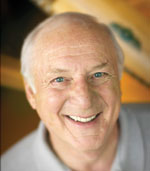Proficient Pilot: Look, Ma, no rudder!
Few airplanes demonstrate no adverse yaw effect
 On one fine day in the mid-1950s, a pilot was departing Santa Monica, California, in a Model 18 Twin Beech that had just been returned to service after extensive maintenance. A slight gust lowered the left wing shortly after liftoff, and the pilot countered with a touch of right aileron. The left bank steepened, however, and the more the pilot applied opposite aileron, the steeper the opposing bank became. As bank angle approached 90 degrees, the pilot suddenly responded to a stroke of sheer brilliance. He reversed aileron input by turning the wheel toward the low wing. The beleaguered twin rolled level, and the pilot continued climbing to pattern altitude while substituting right aileron input when left would normally have been required, and vice versa.
On one fine day in the mid-1950s, a pilot was departing Santa Monica, California, in a Model 18 Twin Beech that had just been returned to service after extensive maintenance. A slight gust lowered the left wing shortly after liftoff, and the pilot countered with a touch of right aileron. The left bank steepened, however, and the more the pilot applied opposite aileron, the steeper the opposing bank became. As bank angle approached 90 degrees, the pilot suddenly responded to a stroke of sheer brilliance. He reversed aileron input by turning the wheel toward the low wing. The beleaguered twin rolled level, and the pilot continued climbing to pattern altitude while substituting right aileron input when left would normally have been required, and vice versa.
You guessed it. The ailerons had inadvertently been rigged backwards, a condition that went undetected until taken airborne. “Having to land the airplane by reversing aileron input,” the pilot later commented, “was extremely challenging and very frightening.”
Many lessons were learned from this flight, not the least of which is that the first flight following maintenance—such as an annual inspection—can be the most dangerous. I seriously doubt if I would have had the presence of mind to apply counterintuitive roll control at such a time. This led me to make a silent promise that I would never allow myself to be caught up in such a conundrum.
Fast forward to January 22, 1975.
I was preparing to start the engines of an Aerostar 601A at the same airport at which the Twin Beech pilot had performed so brilliantly. Standing ahead of and in front of the airplane was its designer, Ted R. Smith, who aimed a camera in my direction. The press was there with their cameras, too. This flight was intended to prove that the Aerostar was indeed the world’s fastest piston-powered business airplane, as the factory brochures had extolled. It would do this by breaking the world speed record for the 500-km closed-circuit course for piston-powered airplanes weighing less than 3,000 kilograms (6,614 pounds). The existing record of 293 mph had been set in a 1,000-horsepower single-engine Yak 11 Moose and held by Y.D. Forostenco of the Soviet Union since 1951.
Obviously wanting his airplane to look as streamlined as possible for the cameras, Smith yelled for me to center the rudder. I noticed that the pedals were even and yelled back, “It is centered, Ted.”
“No, it’s not,” he replied. “Align the pedals.”
“They are aligned, Ted.”
Smith walked over to the cockpit and said with a frown, “We have a problem.”
Moments later, the famed designer crawled into the tail cone of N90337 with a flashlight, some tools, and a rag. When he returned with a few head scratches as evidence of his journey, he said that the rudder was not connected—and that it had been that way ever since I had picked up the new airplane at the Santa Maria, California, factory a week earlier.
I quickly envisioned the consequences of an engine failure shortly after liftoff in such a handicapped airplane. It is not likely that I could have kept the airplane airborne on one engine without rudder power available for directional control. The thought of it still haunts me. On the other hand, it proved how beautifully designed is an airplane that demonstrates no adverse yaw effect. There was no need for rudder during a dozen hours of flying that airplane. I mean, I thought that I was applying rudder when rolling into and out of turns, but obviously was not.
This experience is a reminder that there are many airplanes in which a pilot cannot observe rudder movement. He can only assume that it operates normally when moving the pedals during a preflight run-up. In some airplanes he cannot see the elevator, either.
It is impossible to see any of the primary flight controls from the cockpit of a jetliner, which is why they (and many business jets) are provided with surface position indicators (SPIs). These show the positions of control surfaces at any given time and are especially handy when checking them for free and correct movement before takeoff. Given the proliferation of glass displays in general aviation, it should not be difficult to equip with SPIs those airplanes in which not all primary flight controls can be viewed from the cockpit.
After obtaining the needed and thankfully available hardware, Smith personally hooked up the rudder to its cables and declared the airplane ready to go.
In addition to that valuable lesson, I also picked up a world speed record. The Aerostar sprinted around the 25,000-foot-high, closed-circuit course at 305 mph, a record soon eclipsed by a Bellanca Skyrocket. Oh, well. Records, they say, are made to be broken.
Visit the author’s website.



